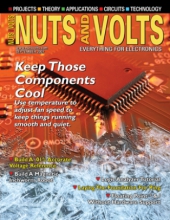Nuts and Volts Magazine
Features
Using Horner’s method to provide floating point support on microprocessors or microcontrollers that don’t have support built in.
The Cell Broadband Engine or Cell/BE processor consists of a “Power Processor Element” (PPE), which is the primary core that generally dictates the work of other cores on the chip...
A logic analyzer — like so many electronic test and measurement tools — provides a solution to a particular class of problems. These include digital hardware debugging, design verification, and embedded software debugging...
Projects
This basic circuit allows you to control the speed of a fan to suit your noise tolerance.
Last month, we introduced you to the basics of model rocketry and outlined the hardware design of a compatible flight recorder. This article will describe the embedded software required to record and replay three channels of acceleration, and includes...
When I first started this series, I knew I wanted to build a wireless weather station. In no way could I have imagined how well the overall system would function, nor could I have envisioned its versatility. In this article, it all comes together...
Okay, you've wired up the latest whiz-bang sensor to your processor-controlled project. The sensor has been connected to the 12-bit A/D and now the moment of truth...
Columns
TechKnowledgey
by Jeff Eckert
Events, Advances, and News
Nanotechnologists at the University of California, Riverside ([url=http://www.ucr.edu]http://www.ucr.edu[/url]) have come up with a way to control the color of a liquid by applying a magnetic field..
In The Spotlight
by Marvin Mallon
An Interview with Mike Leo
Ramsey Electronics is a leading distributor of sophisticated devices for both the hobbyist and the electronic experimenter. Located just south of Rochester, NY, they serve this market both by catalog as well as online sales...
Getting Started With PICS
by Chuck Hellebuyck
Large Digits on a 4x20 LCD
Driving a Liquid Crystal Display (LCD) module has become very easy to do with the various PIC® microcontroller (MCU) options that are available...
Near Space
by L. Paul Verhage
Some Sensors for your Ballonstats and the Great Plains Super Launch
This month we’ll look at two sensors: a miniature near space weather station and a temperature sensor array. With these sensor arrays, your BalloonSat can chart environmental conditions from the ground to near space and measure the temperatures...
Q&A
by Russell Kincaid
Q&A
In this column, I answer questions about all aspects of electronics, including computer hardware, software, circuits, electronic theory, troubleshooting, and anything else of interest to the hobbyist.
Personal Robotics
by Bryan Bergeron
Magnetic Inchworm
Continue reading to learn how to build a simple robot designed to travel over steel or iron surfaces — a magnetic inchworm — with a few servos, a pair of neodymium magnets, and an R/C system...
Stamp Applications
by Jon Williams
Where’s Waldo?
It seems like the animation controller from May was a hit. I got a lot of very positive email and many readers have been creating derivative applications for controlling servos..
The Design Cycle
by Peter Best
Laying A foundation for PING
In the previous edition of Design Cycle, I described the steps that were necessary to “fool” your personal computer (PC) into having a conversation with the Ethernet MINI and the minimal driver code we had completed at that time...
Departments
Developing Perspectives
by Bryan Bergeron
The projects in this issue of Nuts & Volts address a range of interests, from rocketry instrumentation and weather, to thermal management and instrument calibration standards. Although the relevance of standards is most evident in Doug Malone’s article on building a voltage reference, each of the projects is a tribute to the necessity of standards in the design, construction, operation, and maintenance of electronic circuitry and instrumentation...

